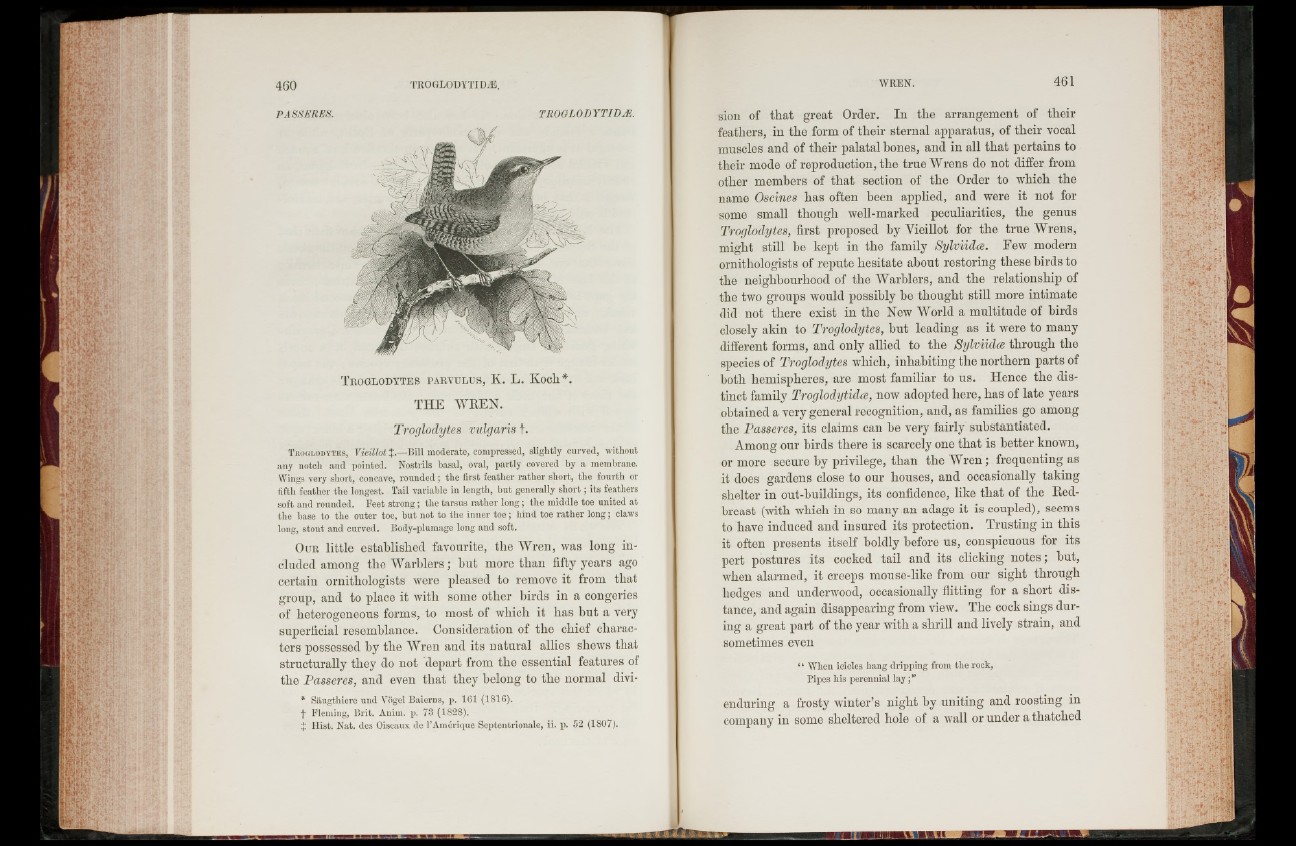
PASSERES. TROGLOD YTJDJi.
T r o g l o d y t e s p a r v u l u s , K. L. Koch*.
THE WREN.
Troglodytes vulgaris t.
Trohlodytes, Vieillot J .—Bill moderate, compressed, slightly curved, without
any notch and pointed. Nostrils basal, oval, partly covered by a membrane.
Wings very short, concave, rounded ; the first feather rather short, the fourth or
fifth feather the longest. Tail variable in length, but generally sh o rt; its feathers
soft and rounded. Feet strong; the tarsus rather long; the middle toe united at
the base to the outer toe, but not to the inner toe ; hind toe rather long; claws
long, stout and curved. Body-plumage long and soft.
O u r little established favourite, the Wren, was long included
among the Warblers; but more than fifty years ago
certain ornithologists were pleased to remove it from that
group, and to place it with some other birds in a congeries
of heterogeneous forms, to most of which it has but a very
superficial resemblance. Consideration of the chief characters
possessed by the Wren and its natural allies shews that
structurally they do not depart from the essential features of
the Passeres, and even that they belong to the normal divi-
* Sangthiere und Vogel Baierns, p. 161 (1816).
f Fleming, Brit. Anirn. p. 73 (1828).
X Hist. Nat. des Oiseaux de l’Amerique Septentrionale, ii. p. 52 (1807).
sion of that great Order. In the arrangement of their
feathers, in the form of their sternal apparatus, of their vocal
muscles and of their palatal bones, and in all that pertains to
their mode of reproduction, the true Wrens do not differ from
other members of that section of the Order to which the
name Oscines has often been applied, and were it not for
some small though well-marked peculiarities, the genus
Troglodytes, first proposed by Vieillot for the true Wrens,
might still be kept in the family Sylviidce. Few modern
ornithologists of repute hesitate about restoring these birds to
the neighbourhood of the Warblers, and the relationship of
the two groups would possibly be thought still more intimate
did not there exist in the New World a multitude of birds
closely akin to Troglodytes, but leading as it were to many
different forms, and only allied to the Sylviidce through the
species of Troglodytes which, inhabiting the northern parts of
both hemispheres, are most familiar to us. Hence the distinct
family Troglodytides, now adopted here, has of late years
obtained a very general recognition, and, as families go among
the Passeres, its claims can be very fairly substantiated.
Among our birds there is scarcely one that is better known,
or more secure by privilege, than the W ren ; frequenting as
it does gardens close to our houses, and occasionally taking
shelter in out-buildings, its confidence, like that of the Redbreast
(with which in so many an adage it is coupled), seems
to have induced and insured its protection. Trusting in this
it often presents itself boldly before us, conspicuous for its
pert postures its cocked tail and its clicking notes; but,
when alarmed, it creeps mouse-like from our sight through
hedges and underwood, occasionally flitting for a short distance,
and again disappearing from view. The cock sings during
a great part of the year with a shrill and lively strain, and
sometimes even
‘‘ When icicles hang dripping from the rock,
Pipes his perennial lay
enduring a frosty winter’s night by uniting and roosting in
company in some sheltered hole of a wall or under a thatched
• t flf I iilL .Ml-A-l.ll